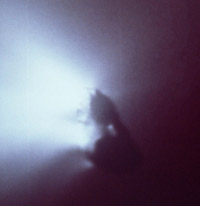
Image of the nucleus of Comet Halley as viewed by Giotto
Build a Comet
An activity by Padi Boyd
related to the song:
'A Little Bit of Rock'
If you're a comet, it's what you're made of that matters. The
chemical composition of comets - the ratio of ices to dust - helps place
limits on theories of their origin. To contain so much ice they must have
formed in the cooler, outer regions of the early solar system. Their
spectacular tails in the night sky are the result of sublimation of the
ices, and of outgassing from the irregularly shaped nucleus. Each time a
comet passes by the Sun, more gas is stripped from the nucleus than dust.
Since ice is very bright and reflective, while carbon dust is dark, older
comets have darker nuclei. The nucleus of a comet is not very dense:
current estimates are about 1.5 g/cm3 - not much denser than
ice!
Since most of the materials in a real comet are easy to obtain,
it's straightforward, and fun to build a scale model of a comet in your
classroom!
This recipe makes a 15-cm comet with chemical composition very close to
that found in actual comets in the solar system. It is a scale model.
You would need to scale the diameter by 100,000 to reach the size of the
nucleus of Halley's comet.
Materials Needed Before You Start:
- 450 grams Dry Ice. Try to get flaked, as opposed to pelleted, dry
ice. This consistency works best when forming the comet. Dry ice is
carried by most ice companies.
- A cooler in which you can store the dry ice
- A mallet or hammer to have on hand to break up any large dry ice
chunks
- A large plastic mixing bowl for each group making a comet
- Thick black plastic lawn bags, two for each comet group
- One pair of thick work gloves for each comet group
- One wooden spoon for each comet group
- Lots of clean-up materials (newspaper, paper towels, etc.)
- One pedestal per comet group. This can simply be a slab of wood,
with a wooden dowel attached
Each group making a comet should collect the following comet
components:
- 470 milliliters (ml) of tap water (H2O) - this will
represent the water ice found in comets,
- 470 ml flaked dry ice (frozen CO2) - this represents other
ices found in comets. CO is also present in comets. We will not bring
this into the classroom! ;-)
- 30 ml of dirt (collect a cup from outside the classroom) - this
represents dust, as well as organic material, found in comets. Most soils
contain a reasonable amount of organic material. If you're in a desert
region, you may want to add another ingredient to represent organic
material, such as sawdust or corn syrup.
- 2 ml ammonia (NH3) - ammonia is another component of
comets
Making the comet:
NOTE: Everyone handling the dry ice during mixing should wear
gloves!
- Line the mixing bowl with one large leaf bag. Cut some of the excess,
but leave a large 'lip' of plastic bag hanging over the edge of the bowl.
- Mix water and dirt in bowl very well.
- Add ammonia and mix well.
- If ice is not flaked, place it in a double-bagged leaf bag (or wrap
it several times in one bag) and use the mallet or hammer to crush the
pieces so there are no clumps. Remember, wear gloves! Dry ice can burn
skin.
- Now, while stirring vigorously and constantly, add the dry ice to the
other ingredients in the mixing bowl.
- Keep stirring. Within several minutes the entire mixture will be
nearly totally frozen.
- You will now be able to lift the bag out of the bowl, with the comet
nucleus inside. With gloved hands, compact the nucleus more tightly.
Remember, it is an icy, dirty snowball after all. Shape it to the
consistency of a snowball.
- At this point the comet nucleus should be able to hold its form when
it is removed from the plastic bag.
- Place the comet on a pedestal. Right away you will see the
sublimation as the dry ice escapes from the comet, going directly from
solid form to gas form. If you have access to a fan, place one comet in a
fan and notice how the trail of gas leaves the nucleus.
- As the day progresses, note how the darkness of the comet changes.
What's left over at the end of the day? Compare this with actual comets.
After a few hours you should see 'cratering' on your comet's surface,
where the carbon dioxide in the comet has sublimated before the ice melts.
You may even see small jets of gas coming from small holes in the comet.
Ice and carbon dioxide will sublimate from a real comet every time its
orbit brings it close to the Sun. Eventually comets may reduce down to a
small rocky core or break into pieces, and the same things should happen
to the classroom comets you or your students have made!
Reference
This activity was adapted from a comet recipe developed by NOAO and found
at: http://www.noao.edu/education/crecipe.html

